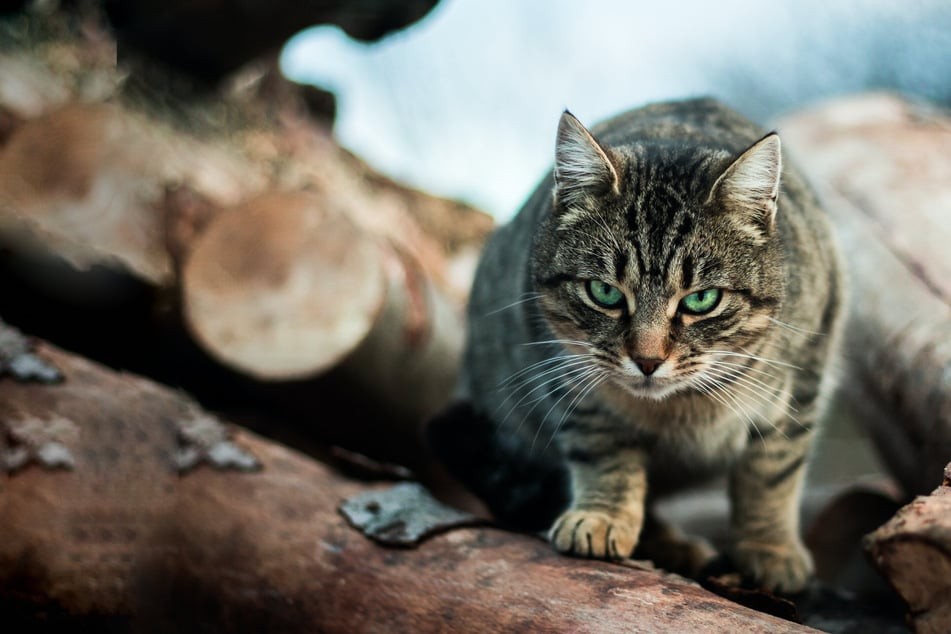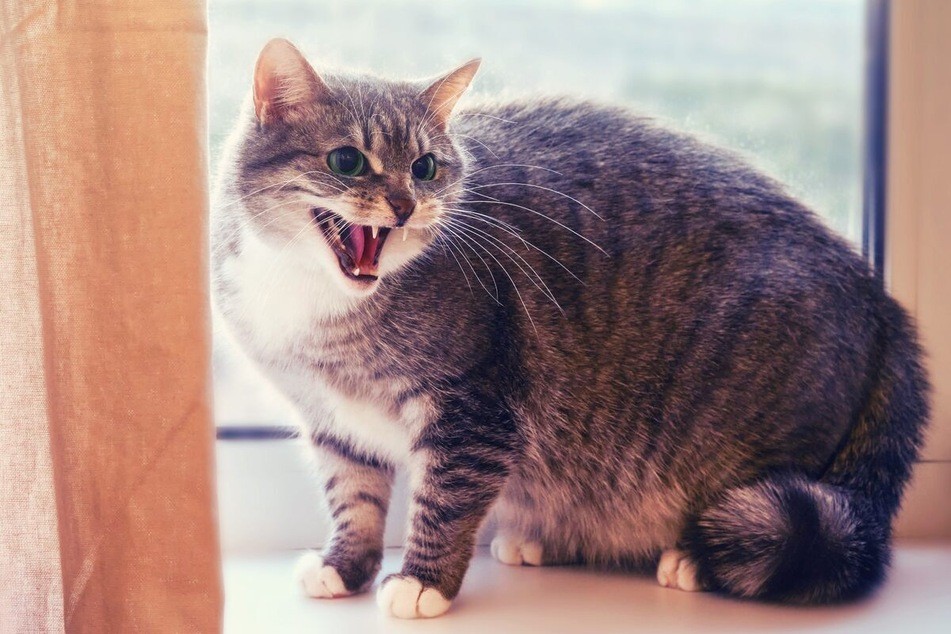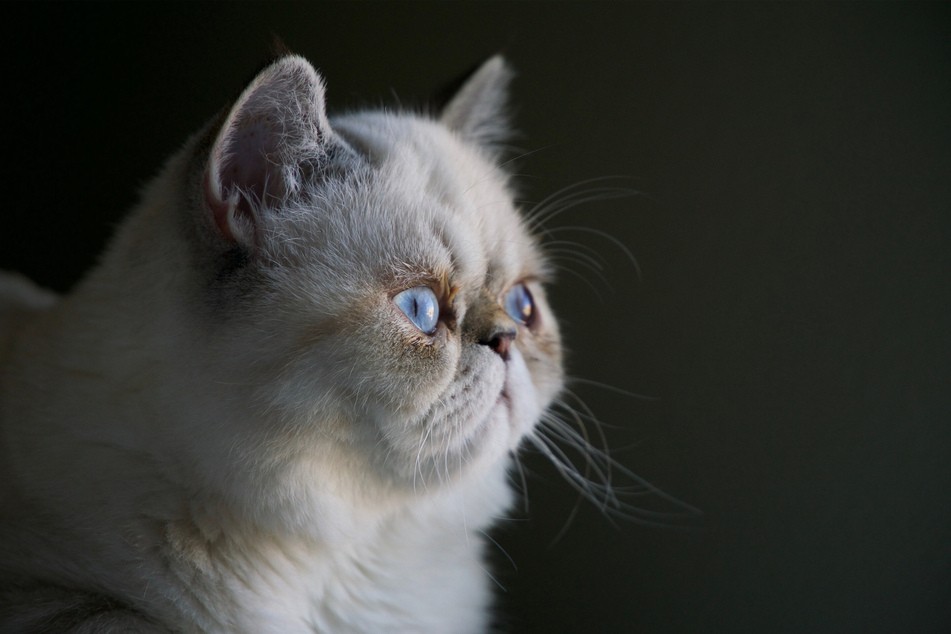Why Does My Cat Duck When I Pet Him? This is a common question among cat owners, and PETS.EDU.VN is here to provide answers. Understanding why your feline friend avoids your touch, whether it’s a sudden flinch or consistent aversion, can strengthen your bond and ensure their well-being. We’ll explore potential reasons, from simple mood changes to underlying health concerns, offering solutions and fostering a happier relationship with your cherished pet. Dive into the world of feline communication, learn about cat anxiety, and discover the best ways to create a comfortable environment for your furry companion.
1. Decoding Your Cat’s Body Language: Why the Duck?
Cats communicate in subtle ways, and a ducking motion during petting is a clear signal. It’s easy to misinterpret this as rejection, but there’s usually a more nuanced explanation. While some cats are naturally less cuddly, a sudden change in behavior warrants closer attention.
1.1. The Importance of Observation
Before jumping to conclusions, observe your cat’s overall demeanor. Is the ducking accompanied by other signs of discomfort, such as flattened ears, a twitching tail, or hissing? These clues can help you narrow down the potential cause.
1.2. Potential Reasons for the Duck
Several factors can contribute to your cat’s aversion to petting. Here are some of the most common:
- Oversimulation: Cats have sensitive skin, and prolonged petting can become overwhelming, leading to a defensive reaction.
- Uncomfortable Touch: Your petting technique might be the culprit. Cats prefer gentle strokes in specific areas, like the head, chin, and back.
- Underlying Pain: A ducking motion could indicate pain in a particular area. If your cat consistently flinches when touched in the same spot, consult a veterinarian.
- Past Trauma: Cats with a history of abuse or neglect may associate touch with negative experiences.
- Fear and Anxiety: Loud noises, new environments, or other stressors can make your cat more sensitive to touch.
2. Understanding Feline Preferences: The Right Way to Pet Your Cat
Just like humans, cats have individual preferences when it comes to physical affection. Learning what your cat enjoys can significantly improve your interactions.
2.1. Identifying Preferred Petting Zones
Most cats enjoy being petted on the head, chin, and neck. These areas are rich in scent glands, and petting them allows your cat to mark you as part of their social group.
2.2. Avoiding Sensitive Areas
The belly is often considered a “no-go zone” for petting. While some cats enjoy belly rubs, most find it threatening, as it leaves them vulnerable. Similarly, avoid petting the tail, as it can be overstimulating.
2.3. The Art of Gentle Touch
Use gentle, slow strokes when petting your cat. Avoid grabbing, squeezing, or patting, as these actions can be perceived as aggressive. Pay attention to your cat’s body language and adjust your technique accordingly.
Table 1: Preferred Petting Zones and Techniques
| Zone | Technique | Reason |
|---|---|---|
| Head | Gentle strokes, scratching | Stimulates scent glands, marks you as part of their group |
| Chin | Gentle scratching, rubbing | Stimulates scent glands, provides comfort |
| Neck | Gentle strokes, scratching | Relaxing and comforting |
| Back | Long, slow strokes | Soothing and relaxing |
| Belly | Avoid unless cat initiates | Can be perceived as threatening, leaves them vulnerable |
| Tail | Avoid or gentle strokes only | Can be overstimulating, some cats dislike being touched there |



3. Is It a Mood or Something More? Recognizing Potential Health Issues
Sometimes, a cat’s aversion to petting is a sign of an underlying health problem. It’s crucial to distinguish between a temporary mood change and a potential medical issue.
3.1. Common Medical Conditions That Cause Sensitivity
Several medical conditions can make cats more sensitive to touch, including:
- Arthritis: Joint pain can make petting uncomfortable, especially in older cats.
- Skin Infections: Skin conditions like allergies, dermatitis, or ringworm can cause itching and pain, making petting unbearable.
- Dental Problems: Dental pain can radiate to the head and neck, making petting in those areas unpleasant.
- Hyperesthesia Syndrome: This neurological condition causes heightened sensitivity to touch, leading to sudden bursts of energy and discomfort.
3.2. Identifying Symptoms of Pain or Discomfort
In addition to ducking, look for other signs of pain or discomfort, such as:
- Lethargy: Reduced activity level and decreased interest in playing.
- Loss of Appetite: Refusing food or eating less than usual.
- Hiding: Spending more time alone and avoiding social interaction.
- Changes in Grooming Habits: Neglecting grooming or over-grooming certain areas.
- Aggression: Hissing, swatting, or biting when touched.
3.3. When to See a Veterinarian
If you suspect your cat is experiencing pain or discomfort, schedule a visit with your veterinarian. They can perform a thorough examination, diagnose the underlying cause, and recommend appropriate treatment.
4. The Impact of Past Experiences: Trauma and Trust
A cat’s past experiences can significantly influence their behavior, especially when it comes to physical touch. Cats who have experienced trauma may be fearful and avoidant of human interaction.
4.1. Recognizing Signs of Trauma
Cats who have experienced trauma may exhibit a variety of behavioral issues, including:
- Fearfulness: Cowering, hiding, and startling easily.
- Aggression: Hissing, swatting, and biting.
- Avoidance: Avoiding eye contact and social interaction.
- Excessive Grooming: Grooming to the point of hair loss.
- Changes in Appetite: Eating more or less than usual.
4.2. Building Trust and Reassurance
Building trust with a traumatized cat requires patience, understanding, and consistency. Here are some tips:
- Create a Safe Space: Provide your cat with a quiet, comfortable space where they can retreat when feeling overwhelmed.
- Use Positive Reinforcement: Reward your cat for positive interactions with treats, praise, and gentle petting.
- Avoid Punishment: Never punish your cat for their behavior, as this will only reinforce their fear.
- Respect Boundaries: Allow your cat to approach you on their own terms and avoid forcing interaction.
- Consider Professional Help: A veterinary behaviorist can provide guidance and support in helping your cat overcome their trauma.
4.3. The Power of Patience and Consistency
It may take months or even years for a traumatized cat to fully trust humans again. Be patient, consistent, and understanding, and celebrate every small step forward.
5. Environmental Factors: Stress and Sensitivity
Changes in the environment can also affect a cat’s sensitivity to touch. Loud noises, new pets, or even rearranging furniture can cause stress and anxiety, leading to a reluctance to be petted.
5.1. Identifying Environmental Stressors
Common environmental stressors for cats include:
- Loud Noises: Construction, thunderstorms, or fireworks.
- New Pets or People: Introducing new animals or people into the household.
- Changes in Routine: Altering feeding schedules or playtime routines.
- Moving: Relocating to a new home.
- Conflicts with Other Pets: Fighting or aggression between cats or other animals.
5.2. Creating a Calming Environment
To reduce stress and anxiety, create a calming environment for your cat:
- Provide Vertical Space: Cats feel safer when they have access to high perches, such as cat trees or shelves.
- Offer Hiding Places: Provide your cat with several hiding places, such as cardboard boxes or covered beds.
- Use Calming Pheromones: Feliway diffusers release synthetic feline pheromones that can help reduce stress and anxiety.
- Maintain a Consistent Routine: Stick to a regular feeding and playtime schedule.
- Minimize Loud Noises: Create a quiet space for your cat during noisy events.
5.3. Gradual Introductions to New Stimuli
When introducing new pets or people, do so gradually and under controlled conditions. Allow your cat to adjust at their own pace and avoid forcing interaction.
6. The Role of Age: Senior Cat Sensitivity
As cats age, they may become more sensitive to touch due to age-related conditions like arthritis and cognitive decline.
6.1. Age-Related Physical Changes
Senior cats often experience physical changes that can make petting uncomfortable, including:
- Arthritis: Joint pain and stiffness.
- Decreased Muscle Mass: Reduced cushioning around bones and joints.
- Thinning Skin: Increased sensitivity to touch.
- Cognitive Dysfunction: Confusion and disorientation.
6.2. Adapting Petting Techniques for Senior Cats
When petting a senior cat, be extra gentle and avoid sensitive areas. Pay attention to their body language and stop if they show signs of discomfort. Consider using a soft brush instead of your hands to avoid irritating their skin.
6.3. Providing Comfort and Support
In addition to adapting your petting techniques, provide your senior cat with extra comfort and support:
- Provide a Soft Bed: Offer a comfortable, supportive bed in a warm, quiet location.
- Maintain a Warm Environment: Keep your home at a comfortable temperature to ease joint pain.
- Provide Easy Access to Resources: Place food, water, and litter boxes in easily accessible locations.
- Consider Pain Management: Talk to your veterinarian about pain management options for arthritis and other age-related conditions.
7. Breed Predispositions: Are Some Cats Just Less Cuddly?
While individual personality plays a significant role, some cat breeds are generally known for being less cuddly than others.
7.1. Independent Breeds
Breeds like Abyssinians, Bengals, and Siamese are known for their intelligence, energy, and independence. While they enjoy human interaction, they may not be as lap-dependent as other breeds.
7.2. Affectionate Breeds
Breeds like Ragdolls, Persians, and Birmans are known for their affectionate and docile nature. They typically enjoy being petted and cuddled.
7.3. The Importance of Individual Personality
Regardless of breed, every cat has a unique personality. Some cats may defy breed stereotypes and be either more or less cuddly than expected.
Table 2: Breed Predispositions
| Breed | Tendency | Description |
|---|---|---|
| Abyssinian | Independent | Intelligent, active, and independent; enjoys human interaction but may not be lap-dependent |
| Bengal | Independent | Energetic, playful, and curious; requires a lot of stimulation and may not be as cuddly as other breeds |
| Siamese | Independent | Vocal, intelligent, and demanding; forms strong bonds with their owners but can be independent at times |
| Ragdoll | Affectionate | Docile, gentle, and affectionate; enjoys being petted and cuddled |
| Persian | Affectionate | Calm, sweet, and affectionate; loves attention and enjoys being pampered |
| Birman | Affectionate | Gentle, affectionate, and playful; enjoys human companionship and is known for being good with children |
8. The Cat-Human Bond: Building a Stronger Relationship
Understanding why your cat ducks when you pet him is just one aspect of building a strong and fulfilling cat-human bond.
8.1. Understanding Feline Communication
Learning to interpret your cat’s body language is essential for effective communication. Pay attention to their ears, tail, eyes, and vocalizations to understand their mood and intentions.
8.2. Providing Enrichment and Stimulation
A bored cat is more likely to develop behavioral problems. Provide your cat with plenty of enrichment and stimulation, such as toys, scratching posts, and interactive playtime.
8.3. Respecting Boundaries and Preferences
Respect your cat’s boundaries and preferences. Allow them to approach you on their own terms and avoid forcing interaction.
8.4. The Benefits of a Strong Bond
A strong cat-human bond benefits both you and your cat. Cats who feel loved and secure are less likely to develop behavioral problems and are more likely to live long, happy lives. Owners who have a strong bond with their cats experience reduced stress, increased companionship, and a greater sense of well-being.
9. Seeking Professional Guidance: When to Consult a Behaviorist
If you’re struggling to understand why your cat ducks when you pet him or if you’re concerned about their behavior, consider consulting a veterinary behaviorist.
9.1. What Is a Veterinary Behaviorist?
A veterinary behaviorist is a veterinarian who has specialized training in animal behavior. They can diagnose and treat behavioral problems in cats and other animals.
9.2. When to Seek Professional Help
Consider consulting a veterinary behaviorist if:
- Your cat’s aversion to petting is sudden or severe.
- Your cat is exhibiting other behavioral problems, such as aggression, anxiety, or compulsive behaviors.
- You’ve tried other solutions without success.
- You’re concerned about your cat’s well-being.
9.3. What to Expect During a Consultation
During a consultation, the veterinary behaviorist will ask you detailed questions about your cat’s history, behavior, and environment. They may also observe your cat’s behavior in person. Based on this information, they will develop a treatment plan tailored to your cat’s individual needs.
10. PETS.EDU.VN: Your Partner in Feline Care
At PETS.EDU.VN, we understand the unique challenges and joys of cat ownership. We’re committed to providing you with the information and resources you need to provide the best possible care for your feline friend.
10.1. Comprehensive Resources and Articles
Our website features a wealth of articles and resources on cat behavior, health, nutrition, and training. Whether you’re a new cat owner or a seasoned pro, you’ll find valuable information to help you care for your cat.
10.2. Expert Advice and Support
Our team of veterinary experts is available to answer your questions and provide personalized advice. We’re here to support you every step of the way.
10.3. Connecting You with Local Services
We can help you find local veterinarians, groomers, and other pet care providers in your area. We’re committed to connecting you with the resources you need to care for your cat.
Understanding why your cat ducks when you pet him is just the beginning. At PETS.EDU.VN, we’re dedicated to helping you build a strong and fulfilling relationship with your feline companion. Explore our website for more information on cat care, or contact us today for personalized advice. Visit us at 789 Paw Lane, Petville, CA 91234, United States. Reach out via Whatsapp at +1 555-987-6543. Or browse our website at PETS.EDU.VN. Discover more in-depth guides on feline health, and learn how to address cat anxiety effectively at PETS.EDU.VN. Your cat will thank you!
FAQ: Understanding Why Your Cat Ducks When Petted
-
Why does my cat suddenly duck when I try to pet him?
Sudden changes in behavior can indicate a health issue, stress, or discomfort. Observe other symptoms and consult a vet if needed. -
Is it normal for cats to dislike being petted on certain areas?
Yes, cats have preferences. Most enjoy head, chin, and neck petting, but avoid the belly unless they initiate. -
Could my petting technique be the reason my cat ducks?
Yes, use gentle strokes and avoid grabbing or patting. Observe your cat’s reaction and adjust accordingly. -
Can past trauma cause my cat to avoid being touched?
Yes, traumatized cats may associate touch with negative experiences. Build trust with patience and positive reinforcement. -
How can I create a more calming environment for my cat?
Provide vertical space, hiding places, calming pheromones, and maintain a consistent routine. -
Do senior cats become more sensitive to touch?
Yes, age-related conditions like arthritis can make petting uncomfortable. Adapt your techniques for senior cats. -
Are some cat breeds naturally less cuddly?
Yes, breeds like Abyssinians and Bengals are more independent. However, individual personality matters most. -
When should I consult a veterinary behaviorist?
If the aversion is sudden, severe, or accompanied by other behavioral problems. -
What can I expect during a veterinary behaviorist consultation?
Detailed questions about your cat’s history, behavior, and environment, leading to a tailored treatment plan. -
Where can I find more resources on cat care?
Visit pets.edu.vn for comprehensive articles, expert advice, and local service connections.
